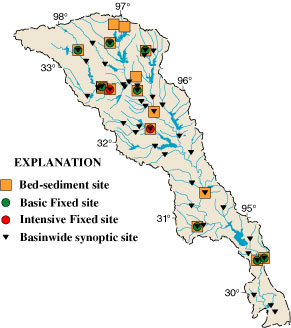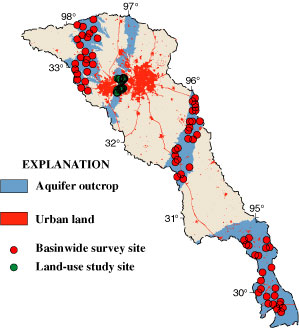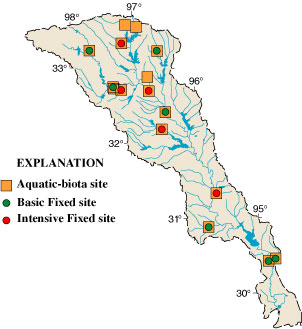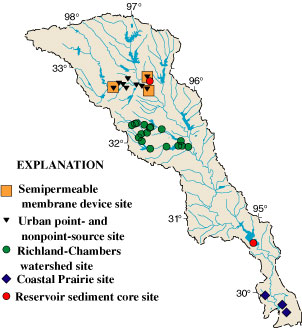and Bed Sediment


Chemistry of Surface Water
and Bed Sediment

Chemistry of Ground Water

Aquatic Biology

Special Studies

![]()
Location of data-collection sites.
Summary of data collection in the Trinity River Basin Study Unit, 1992-95
| Study component | Objectives |
Brief description and water-quality measures |
Number of sites |
Frequency during 1993-95 |
|---|---|---|---|---|
| Chemistry of surface water and bed sediment | ||||
| Water chemistry—Basic and Intensive Fixed sites | Describe concentrations and loads of water-quality constituents at selected stream sites. | Sample at or near streamflow-gaging stations. Basic sites are sampled for major ions, organic carbon, suspended sediment, and nutrients. Intensive sites are a subset of the Basic sites and include sampling for pesticides. |
8
Basic; 2 Intensive |
~14
per year at Basic; ~25 per year at Intensive |
| Water chemistry— Basinwide synoptic studies |
Describe short-term presence and distribution of contamination over the entire basin and how well the Basic and Intensive sites represent the Trinity River Basin. | Sample streams during winter base-flow and spring runoff conditions for major ions, organic carbon, suspended sediment, nutrients, and pesticides. | 43 | 2 |
| Bed-sediment contamination— Presence and distribution survey | Determine presence of potentially toxic compounds attached to sediment deposited on streambeds. | Sample
depositional zones of streams for trace elements and hydrophobic organic compounds. |
16 | 1 |
| Aquatic biology | ||||
| Ecological assessments— Basic and Intensive Fixed sites | Assess in detail biological communities and habitat in streams representing primary ecological and land-use regions. | Sample and quantify fish, macroinvertebrates, and algae in streams at stream-chemistry sites and describe stream habitat. Intensive sites are a subset of the Basic sites where there is replicate sampling over three stream reaches. |
7
Basic; 5 Intensive |
1
at Basic; 1 per year and multiple reaches at Intensive |
| Aquatic-biota contamination—Presence and distribution survey | Determine presence of contaminants that can accumulate in tissues of aquatic biota. | Collect clam and fish species that are present in most streams of the Trinity River Basin. Sample composites of clams or fish for organic compounds and trace elements. | 16 | 1 |
| Chemistry of ground water | ||||
|
Water chemistry— |
Describe the overall water quality and natural chemical patterns of water in aquifers. | Sample existing supply wells in the outcrop of three major aquifers for major ions, nutrients, pesticides, trace elements, and VOCs. | 71 | 1 |
| Water chemistry—Land-use study | Determine the effects of urban land use on the quality of shallow ground water. | Sample shallow monitoring and supply wells where there is residential and commercial development for major ions, nutrients, pesticides, trace elements, and VOCs. | 38 | 1 |
| Water chemistry—Flow-path study | Describe changes in water quality in an urban area along flow paths from a shallow aquifer to small streams. |
Sample
clusters of wells in land-use effects survey and a nearby small stream for major ions, nutrients, pesticides, and age-dating constituents. |
3 | 1 |
| Special studies | ||||
| Water chemistry—Use of SPMDs | Determine presence of organic contaminants in water and sediment by deploying caged clams and SPMDs and comparing the results of the two approaches. | Deploy caged native clams and SPMDs side by side for 1 month and determine the presence and concentration of PCBs and PAHs in each medium. | 3 | 1 |
| Water chemistry— Comparison of urban point- and nonpoint-source contaminants |
Compare the presence and distribution of nutrients and pesticides in small urban streams and in effluent from regional wastewater-treatment plants in the same service area. |
Sample
streams and effluent from regional wastewater-treatment plants during late winter to summer for major ions, nutrients, and pesticides. |
6
streams: 3 wastewater- treatment plants |
6 |
| Water chemistry— Richland-Chambers watershed |
Describe presence and distribution of agricultural chemicals in streams and reservoirs in a major crop-producing area. | Sample streams from late winter to late summer for major ions, nutrients, pesticides, and suspended sediment. Reservoirs sampled at beginning or end of study, or both. | 5 streams; 11 reservoirs | 7
at streams; 1 or 2 at reservoirs |
| Water chemistry—Coastal Prairie agricultural area | Describe presence and distribution of agricultural chemicals in streams in a major crop-producing area with irrigation. | Sample streams for 1 year for major inorganic ions, nutrients, pesticides, and suspended sediment. Sampling much more frequent during late spring and summer than fall and winter. | 3 | ~25 |
| Water-quality trends— Reservoir sediment cores |
Determine temporal trends of trace elements, organochlorine compounds, and PAHs in streams. | Collect sediment cores at Lake Livingston and White Rock Lake. Horizontal slices analyzed for age-dating elements, trace elements, organochlorine compounds, and PAHs. | 2 reservoirs | 1 |
| AccessibilityFOIAPrivacyPolicies and Notices | |
 |
|